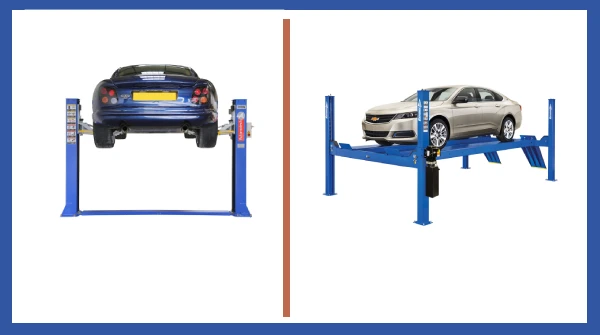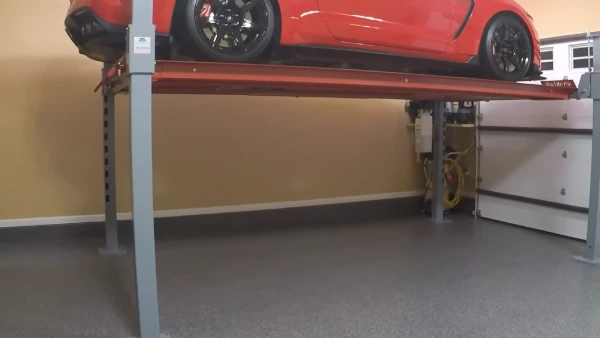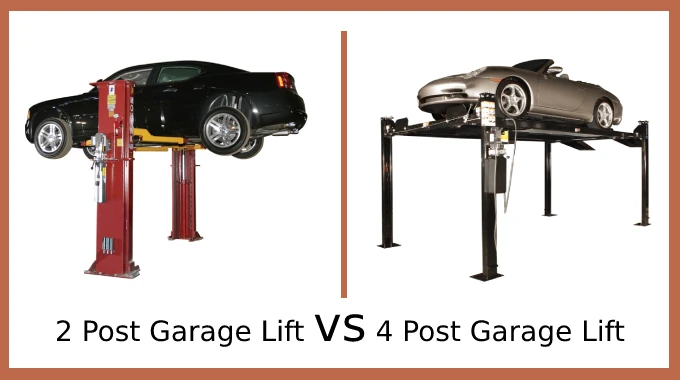Last Updated on April 12, 2023
Whether you’re just starting in your home garage or a seasoned DIYer, having the right vehicle lift is essential. And when it comes to choosing between two-post and four-post lifts, there’s certainly a lot to consider.
2 post lifts have two columns supporting the vehicle, each with its own hydraulic cylinder. And 4 post lifts have four columns that support the vehicle, with two columns in the front and two in the back.
Two-post lifts are typically more compact and require less floor space than four-post lifts. But four-post lifts are generally more stable and versatile than two-post lifts.
Here, we’ll look at the main differences between 2 post vs 4 post garage lifts and discuss similarities, too. We’ll also examine which type of lift might best suit your needs based on its accessibility design, capacity, height, versatility, and more.
2 Post Vs 4 Post Garage Lift: What Are the Main Differences?

While both lifts provide similar benefits, such as raising vehicles off the ground for easy maintenance, they each offer unique advantages that make them ideal for different situations. Knowing the differences between these two lifts, you’ll know which one to choose.
01: Vehicle Accessibility Design
The differences between home garage lift 4 post vs 2 post lift are pretty significant regarding vehicle accessibility design.
When using a 2-post lift, the car being serviced is elevated off the ground, allowing easy access to the undercarriage for maintenance and repair work.
The main advantage of this type of lift is that it takes up less space since there are only two posts needed to raise and lower the car. But, since there is no support between the two posts, it may not be as stable as a 4-post lift.
A 4 post lift offers more stability than a two-post lift but takes up more room in the garage. With four posts supporting the car, you can get greater access to all sides of the vehicle with less risk of tipping over or shifting out of place while being worked on.
Their strength makes them ideal if you want to do more extensive work on a vehicle, like an alignment or suspension repair. Furthermore, 4-post lifts usually have higher weight capacities than 2-post lifts, which can easily support heavier vehicles.
02: Lift Capacity
The capacity rating of a 4-post lift is usually higher than that of a 2-post lift, so you can use them to service heavier vehicles without worrying about damaging your equipment or causing safety issues.
On average, four post lifts come with ratings ranging from 8,000 lbs up to 18,000 lbs depending on the model and manufacturer’s specs. Meanwhile, 2 post lifts have an average capacity range from 6,000 lbs to 12,000 lbs depending on their model and manufacturer’s specs.
Both lifts differ significantly in capacity ratings, so you need to know what kind of vehicles you will be servicing before choosing a lift.
03: Height of Lift
The height ratings of two-post and four-post lifts are usually the same. They can lift cars and trucks up to around 8 to 107 inches, depending on the make and model. Some manufacturers make special “low ceiling” models for garages with lower ceilings.
These lifts have shorter posts, so they fit better in small spaces but still give you plenty of space to work on cars or trucks. But it’s important to remember that the higher the lift, the more capacity it will have.
Moreover, 4-post lifts have added benefits when it comes to height. As their name suggests, they are typically higher than a two-post lift and can be used to raise vehicles off the ground for storage or bodywork repair.
04: Versatility
Two-post and four-post car lifts both let mechanics easily get access to a car. They also help keep the vehicle stable when doing jobs like brake or oil changes that require lifting it up.
Four-post car lifts have an advantage over two-post ones in bigger repair jobs, like wheel alignments or engine repairs, since they’re stronger and have more support at each corner point. This makes them better at keeping the vehicle stable during these repairs.
05: Space Requirements
Four-post lift designs need more space because they have an extra set of vertical supports at each corner. Two-post lift designs are much better if you don’t have a lot of space because they only have two vertical supports near each corner.
If the weight requirement isn’t too much, two-post lifts are ideal for small spaces. And if you need more weight capacity, then four-post lifts are the way to go.
06: Installation Requirements
A 2-post lift is usually much easier to install than a 4-post lift. It typically comes pre assembled and only requires the user to secure it in place with anchors and bolts.
On the other hand, a 4-post lift typically requires more extensive installation, which may involve professional assistance. For example, you may need to pour concrete for the foundations of all four posts, whereas with a 2 post lift, you likely just need two anchor points on the floor or wall.
And because of how they’re designed, 4 post lifts require more space since they have four pillars that support them from below. On the other hand, 2 post lifts allow for more flexibility when it comes to placement since there are no columns involved.
07: Safety Features
Regarding safety features, both types of lifts offer good protection for mechanics and DIYers alike.
For example, both lifts have locking mechanisms that prevent accidental release while working on vehicles and anti-sway blocks that help keep cars in place during use.
But, 4-post lifts are often considered safer due to their design. They provide additional support from both sides of the car as compared to a 2 post lift that only supports from one side of the vehicle.
Also, many 4 post lifts feature additional safety features such as rubber padding under the arms or rolling bridge jacks that help minimize wear and tear on the tires while lifting them off the ground.
08: User-Friendliness
In terms of user-friendliness, both types of garages offer great convenience when it comes to doing work on your car or truck.
With a 2-post lift, you can easily access any part of your vehicle without having to move around too much. This also makes for quicker repairs since you don’t have to adjust anything manually like you would with a 4 post lift.
On the other hand, some find that using a 4-post lift is easier due to its larger size and ability to hold heavier vehicles. This design also allows you to see what you’re doing from all sides of your vehicle, so you won’t have to strain your neck looking up and down throughout your repair.
09: Maintenance Requirements
Regarding maintenance requirements, both types of lifts require regular maintenance to ensure they remain safe and operate correctly over time.
Two-post lifts are easier to take care of because you can easily see the parts that need to be inspected or replaced. With four-post lifts, some parts may be hidden behind other pieces, so it’s harder and sometimes impossible to reach them without taking things apart first.
If something breaks on a two-post lift, you usually just need to replace the broken part. But with a four-post lift, it could cost more since you might have to replace several parts at once for it all to work properly again.
10: Durability and Price
When you compare the durability and price of these two types of lifts, it’s hard to pick one that is better. It all depends on your budget and what you need from a lift.
2-post garages tend to be cheaper but can break down with heavy use over time. 4-post garages cost more upfront but usually last longer because they are stronger for heavier vehicles like trucks or SUVs.
You should think about which type of lift fits your needs and budget before making a choice. Either way, you’ll enjoy the convenience of having a reliable and safe lift that can help you work on your vehicle with ease.
What Are the Similarities between 4 Post Vs 2 Post Lift?

The basic design and function of 4 post and 2-post lifts may differ depending on how they are used, but they do have some similarities in terms of their advantages and disadvantages.
i) The most apparent similarity is that they lift cars off the ground for easier access and maintenance. Both lifts use hydraulic power to raise and lower the vehicle, making them easy to use.
And both types of lifts can be used for various purposes, such as changing oil or brakes, rotating tires, or simply locking a vehicle in a garage.
ii) Another similarity between 4 post and 2 post lifts is that they both require an anchor system to secure the lift safely to the ground. While in use, this prevents the lift from moving and causing accidents.
iii) Finally, both lifts come in various sizes, so you can find one that fits your needs perfectly. Whether you need a small lift for home use or a larger one for professional use, you can find one that meets your requirements.
Can You Use a 4 Post Garage Lift for Your UTV?
Customize your 4 post garage lift for a UTV and enjoy two secure methods to keep it in place. With this setup you can easily move, store or work on your off-road vehicle with peace of mind. We recommend you use a UTV garage lift for ultimate safety.
Method 1. Using a Chain
Make your UTV ride stable with a simple solution. Attach the rear support to the tractor axle using a chain, then suspend it at an angle of 45 degrees. Enjoy more enjoyable and secure adventures.
Method 2. Building a Box:
You can build a box out of 2x4s to create a bridge between two metal ramps so that you can drive the UTV on top of them. The measurements for this particular mower should be long enough to stretch from ramp-to-ramp and ensure that there is 1″ of tire on each ramp for extra safety.
Additionally, you will need four 2x4s that are 40 1/2 inches long and two other 2x4s, which should measure 38″ and 44″. Lastly, two additional small pieces measuring 5 3/4″ and 2 3/4″ should be added. This will enable you to secure your UTV on the lift safely.
Construct a sturdy box crafted from 2×4’s to form an impressive bridge between two metal ramps. This amazing feat will be capped off with the placement of your UTV atop this structure, which is sized just right for it. With 1″ extra tire clearance on each ramp added for good measure, you can feel secure knowing that nothing bad happens during its journey across this makeshift road.
How Do You Find the Right Garage Lift for UTV?
Keeping your vehicle secure and safe while being worked on or stored is a must, however knowing which UTV garage lift to choose can be difficult. That’s why we reviewed the best utv garage lift on the market so you don’t have to.
With our helpful tips for choosing just the right one, finding that ideal solution for securing your ride will become a piece of cake. Garage lifts can be powered either by manual hydraulic means or electrical hydraulic means.
Manual hydraulic lifts are more affordable but require more physical effort from the user when raising and lowering vehicles than their electric counterparts. Electric models tend to be pricier but provide smoother operation and greater speed (they can raise cars up quickly).
It is also important to consider the load capacity of your lift and its maximum lifting height. Selecting a lift with too low of a capacity rating for your vehicle can cause serious safety issues and damage.
On the other hand, selecting a lift with too high of a capacity rating can lead to unnecessary expenses. If possible, purchase a lift designed specifically for your vehicle’s make and model.
You should also consider how much vertical space you have available in your garage or shop. This information will help you decide whether an overhead hoist or ground-level model will suit your needs and space constraints.
Can You Store a Car on a 2 Post Lift?
You can store your car on a two-post garage lift, but be aware of the risks:
- Two-post lifts are designed for lifting cars up to perform maintenance or repairs. They are not intended for long-term storage, as the vehicle’s weight can cause structural damage over time.
- These lifts do not provide any protection from the elements, meaning that your car may be exposed to rain, snow, and other weather conditions while stored on the lift.
If you decide to utilize a two-post garage lift to store your vehicle, it is important to ensure that the lift is properly rated for the weight of your vehicle. You should also protect your car from the elements by covering it with a tarp or other protective material.
Overall, storing a car on a two-post garage lift can be done safely if done correctly.
Do 4-Post Lifts Need To Be Bolted Down?

Four-post lifts require bolts to remain stable and secure. This is especially important for heavier vehicles or those with a higher center of gravity.
The process of bolting down a lift requires anchoring it to the floor with bolts and then connecting the columns to the base plates. This ensures that the lift will stay in place even when lifting heavy loads.
Can You Change Tires On A 4-Post Lift?
Changing tires on a four-post lift is not recommended. This lift typically doesn’t come with a drive-on platform, which is necessary for safely and efficiently changing a car tire. It also lacks clearance for accessing brake components.
Instead, these lifts are designed to raise the entire car off the ground so that repairs can be made underneath the vehicle without putting strain on any suspension components. Wheels-free work should be done with a two-post or scissor lift instead.
What Should You Never Do With a Car Lift?
Whenever operating a vehicle lift, there are certain safety measures that must be met to ensure everyone’s safety as well as protect your investment.
- To start, always check to ensure the area around the lift is clear of people, tools, and equipment before lowering the vehicle.
- Also, never stand in front of or around the lift/vehicle while it’s being raised or lowered.
- Lastly, it’s crucial never to overload your lift beyond its capacity, as this could cause serious damage to both you and your equipment.
Understanding 2-Post and 4-Post Garage Lifts
When choosing the right vehicle lift for your home garage, there are many factors to consider. Understanding the main differences between a 2-post and 4-post lift is essential in helping you make an informed decision.
The two types of lifts have different vehicle accessibility designs and capacities and varying levels of versatility regarding space and installation requirements.
Safety features must also be considered when selecting a vehicle lift, as well as user-friendliness, maintenance requirements and durability, and price. It’s also important to consider any similarities between the two types of lifts before making your final decision.
Ultimately, which type of lift is better for your needs depends on your specific situation.
